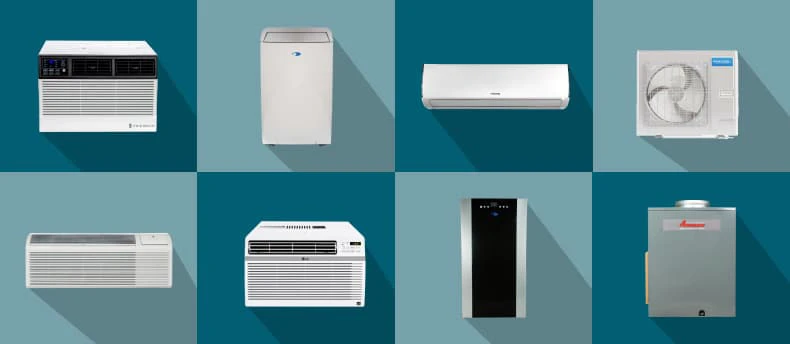Because the heating and cooling system you choose now will probably be in operation for a decade to come or more, it’s crucial to take your time in researching your options and making a decision. Learn about the pros and cons of each HVAC system type.
When deciding on an air conditioning, ventilation, and heating (HVAC) system for your home, it is important to take into account your geographical location, the average temperature of your home throughout the year and the present installation systems (including radiators as well as ducts, and pipes).
Heating and cooling system:
Most householders still rely on the tried-and-true combo air conditioner for heating and cooling. This system pulls in air from inside the house and distributes it throughout the ducting. Heating and cooling can be provided to every room in the house using this approach also known as “forced air”. While most air conditioners rely on electricity, heaters can be powered by propane, natural gas, petroleum or electricity.
Ductless mini-split systems:
Mini-split ductless HVAC systems have grown in popularity. The heat pump used in this system can be used for both heating and cooling purposes. Air handlers are an integral part of wall-mounted indoor units. Because of its efficiency and construction, ducts are unnecessary. For whole-house comfort, outdoor units can be linked to several internal air handlers. Mini-splits can also be used to regulate the temperature in an individual room or an addition to an existing house.
A geothermal heat pump:
Coolest type of HVAC system is also the rarest for obvious reasons. Using the earth as a heat source is referred to as geothermal. Heat pump units are the most eco-friendly and cost-effective HVAC option. The system functions similarly to air-source heat pumps in that it transfers heat rather than producing it. This is effective because heat is exchanged via the earth’s surface rather than the ambient air. The fact that geothermal HVAC systems use so little fuel and electricity is their biggest selling feature.
Split system:
Split cooling and heating units are the most typical HVAC setups in homes. They have a pair of components, one for heating the other for cooling, and a standard thermostat to regulate the building’s temperature. The heating unit for a split-system building is typically hidden away in the basement, service closet or some other out-of-the-way indoor location.
The gas-powered heater blows hot air through a building’s ducts with the help of an evaporator or fan. However, the air conditioning unit is installed externally and linked to the building’s ducts by means of a conduit system. Compressors, coils and refrigerant generate cold air, and a fan exhausts stale, hot air from the structure.
The hybrid split system:
The heat source of a hybrid split air conditioning unit is not limited to gas but also includes electricity. It has a gas hob and an electric option for heating. While electric heating systems are often less efficient and less effective than gas-powered ones, they can allow building owners greater control over their energy consumption, which is especially helpful in warmer climates where heating expenses tend to be higher.
Zones system:
Building occupants can regulate the temperature of individual rooms or zones with the help of HVAC zoning systems. Depending on the capacity of the facility, specialists could zone ducted air conditioning systems in several different ways. It’s not uncommon for homeowners of multi-story homes to install separate HVAC units on each floor.
Because each zone has its own heating and cooling system, this method of zoning necessitates the installation of multiple HVAC systems. Installing dampers, either manually or automatically, in the system’s ducts is another typical method of zoning.
By partially shutting a damper, airflow can be controlled in one zone while being redirected towards another. By diverting air from areas that don’t need it, this sort of zoning reduces energy consumption without sacrificing comfort for building inhabitants.
Mini-split air conditioner without ducts:
Mini-split ductless HVAC systems are becoming increasingly widespread in multi-family dwellings, commercial buildings and hotels. These electric devices, also referred to as mini-split systems, consist of an exterior compressor including condenser, refrigerant, an internal air-handling system, a heat pump, power connections, and a control panel for each zone. One compressor can be linked to as many as nine air handlers inside the building through copper tubing.
Ductless systems may be more costly to set up initially, but they can save money and resources in the long run. Users can save money by only heating or cooling the rooms they need, eliminating ductwork-related energy loss. A secondary heating system is usually necessary for those who live in colder climates because the heating parts are less efficient at sub-freezing temperatures.
Portable cooling system:
Spot coolers are mobile air conditioning systems intended to cool off large indoor or outdoor areas quickly and efficiently. They pull in room air, circulate it through a closed-loop refrigerant-cooled coil, and then release it again into the room. The condensation left over after the coil has cooled and dehumidified the air can be collected in a hose and catch bucket.
Spot coolers are mobile and may be used everywhere there is access to electricity because of their built-in motors and wheels. However, installation in confined locations can be more challenging because of the lack of an obvious exhaust outlet. Spot coolers chill the air and then expel the warm air through a bendy tube. This hose can be lengthened and must exit the building by an open door, window or false ceiling.


